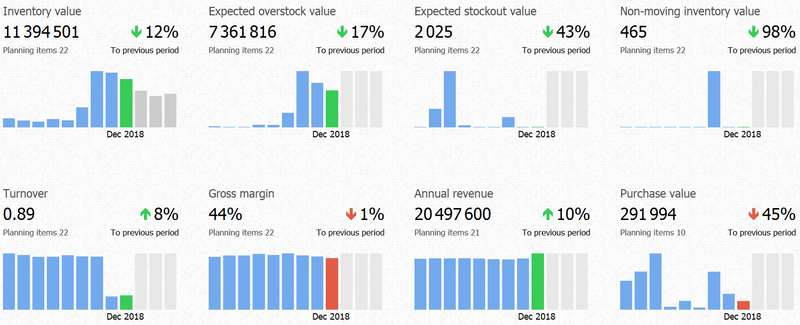Imagine the scenario; a customer sees a product that they absolutely love, spend some time looking at the description, maybe check reviews, then make the decision to purchase. They then move to the checkout process only to discover the product is currently out of stock.
Not only is this annoying to the customer, it can also reflect badly on your brand as a whole.
Inventory management problems are something every business experiences at some point. In some cases, the reasons may be unavoidable (for example, major technical issues with the manufacturers), but in most cases, the problems stem from internal processes and systems, and very much can be avoided.
So, what are the most common inventory management problems you should avoid if your business sells online? How do you spot them and what can you do to avoid them?

The Five Most Common Inventory Management Problems
Knowing the most common inventory management problems you may encounter can help you prevent them from happening.
1. Lack of Automation
Human error can be a major problem when it comes to inventory issues. If you’re relying on your staff to be responsible for all inventory management and you’re using a manual recording method, such as Excel, then problems are inevitable.
Numbers entered incorrectly (either in a stock count or when reordering) means that discrepancies will always arise.
If you operate more than one warehouse to fulfil orders, then not using a good warehouse management system means it is almost impossible to have an accurate overview of stock levels or an idea where the most orders come from so that you can have sufficient stock in the relevant warehouse location.
When you operate an ecommerce store, it’s very likely that you operate a multichannel business. Without automated solutions, this could cause major issues when the numbers of SKUs are not linked across those channels.
Multichannel inventory sync can help bring your channels together and ensure that you avoid over or understocking.
Of course, there may be instances (such as the aforementioned issues at manufacturing level) where running out of a product could be unavoidable.
What you can try and do in those circumstances is to turn a negative into a positive. If you know when a product will be back in stock, you can allow customers to pre-order, for instance. Out of stock products can be used to your advantage.
2. Poor Forecasting

A major part of deciding how much stock you carry is the forecast you’ve made based on various factors such as previous sales figures, average order value, and seasonal fluctuations. For example, if you sell Christmas trees, there is usually only a 3-4 month (at most) window in which you sell them in any significant numbers.
If in previous years, you have sold an average of 5,000 SKUs in each relevant period, then you’ll probably order stock to cover that previous demand.
However, if a major competitor has gone out of business and you’ve not factored that into your forecasts, then you may see a significant difference between what you have in stock and attempted orders.
Or you may have added a Facebook Store, without taking into account increased demand.
This should be an exception rather than a rule. If you’re tracking your metrics and your SKUs accurately, then your forecasts should be on point more often than they’re not.
Some things, though, such as a global pandemic are almost impossible to plan for. Supply and demand will always be disrupted by such crises, but you can, at the very least, still maintain good customer service in the face of a pandemic.
3. Poorly Trained Staff

While human error has already been mentioned as a factor in inventory management problems, the human element can go beyond simple mistakes.
If you don’t invest in training your employees well, you won’t only face potential issues with your inventory, but also with staff retention, which in turn can add to your costs in recruiting and onboarding new staff.
Lack of training can be a crucial error where you use automation or software-based systems. If a staff member doesn’t know how to properly use such systems, then errors are bound to happen.
A great example of systems where you need to train staff well are your order management solutions. If people don’t know how to use them well, your business will suffer.
Lack of training can have negative effects in areas other than software or automation.
Failing to train your employees in basic warehousing tasks, such as stacking pallets or operating a forklift, could result in damaged stock which cannot be sold and which has a knock-on effect on your inventory management generally.
As with other things, inventory management training should not be a static or one-off action. If you make any changes to your processes, or if you integrate new systems or automation, ensure all relevant staff receive the training required.
It’s even worth including retraining or refresher courses to make sure that staff are still following what they originally learned.
4. Warehouse organization

If your warehouse is not organized efficiently, then many tasks may take more time than they should, and that impacts your costs and profitability.
If your best selling items are hard to get to, then staff spend more time retrieving them, which in turn means it’s taking you longer to fulfil orders. Your warehouse should be well organized so your staff work more efficiently.
What you should be doing is adopting the ABC method (based on the Pareto Principle).
What this means is you should focus on category “A” products, or the SKUs that make up around 80% of your orders and sales. Category “B” is then your middle-performing SKUs, and “C” is those products for which there is less demand and which are of lower priority.
Warehousing is an area that can greatly benefit from efficient task management solutions. Your warehouse should follow the old adage of “’a place for everything and everything in its place”.
Sort your warehouse according to the ABC method as well as possible segmentation according to product types if you carry a wide range. For example, electrical goods and clothing should be stored in two different areas.
As with other areas, any reorganization should not be a one off exercise. Where products fit into your ABC system may change over time, you may significantly expand your product range or even the size of your warehouse, or you may see other changes.
Revisit your organizational plan at least annually to be sure that it still meets the current demands placed on it.
5. Outdated Systems

Though it is to be hoped that you’ve moved beyond archaic inventory management processes such as filling in an Excel sheet, the constantly changing world of software and automation means that some of your systems may now also be outdated.
There may be scenarios where you implement new tech that does not integrate well (or at all) with existing systems.
Where you have larger, or multiple, warehouses, you need software and automated systems that integrate well and “talk” to each other. Where this is not the case, then you’re again relying on your staff to transfer or input data from one system to another.
This in turn can lead to human error which means more potential inventory management problems as well as being a time-consuming task.
You should look at what your primary software or automation solutions are. You should then see what current systems easily integrate with those and what tools or software may need to get replaced or updated.
The main two areas you probably need integrated and working together the most are sales and inventory management, with the latter being updated in real time according to changes in the former.
Why focus on integration? The more your systems are integrated, the less work for you and your staff, the more accurate tracking and metrics, and the lower likelihood of under or overstocking.
You want all your processes related to inventory to be like a well-oiled machine: Operating smoothly and improving efficiency.
While, of course, there are costs involved in buying new systems or updating old ones, you have to consider the long term savings such changes will make.
For many solutions, especially those in the SaaS sector, companies are constantly looking to make improvements and these upgrades are often included as part of your monthly or annual fees.
The Takeaway
Now that we’ve taken a look at some of the methods for branding, let’s take a look at some trends for branding your company in 2022.
Most inventory management problems, while annoying, are comparatively easy to solve. By considering the main issues discussed, you can easily identify any gaps in your current systems and processes and, hopefully, take steps to rectify those gaps.
What you do have to remember is that continued inventory issues can cause not only lost sales, but also damage to your brand.
Having a good supply chain, from manufacturing to warehousing and order fulfilment, is an essential factor in ecommerce. Keeping your customers happy, and seeing them return to purchase again and again, is one of your main reasons for operating.
At the heart of that lies the principle of managing your inventory efficiently to ensure a high level of order fulfilment.




